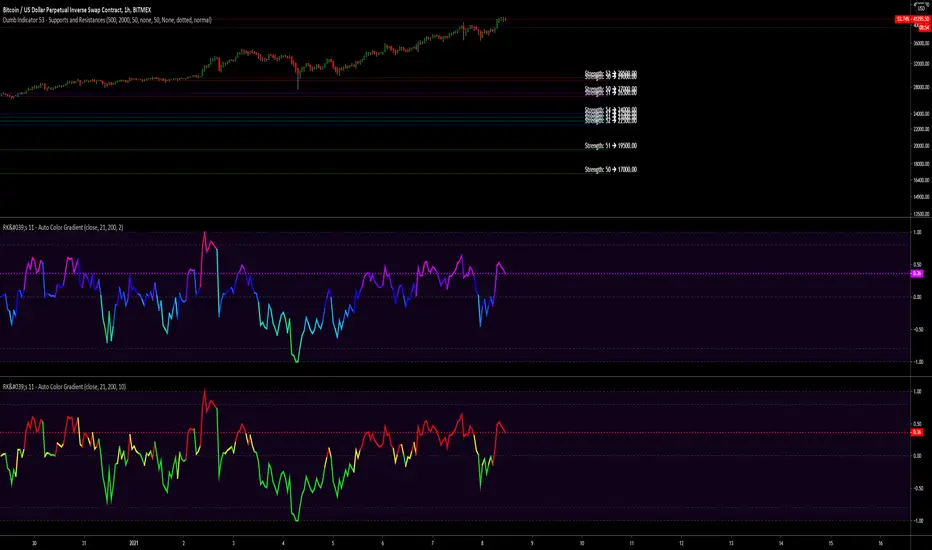This started as a personal arrays study, but after a few tests I decided to made a framework to get my own scripts simplest, lighter and faster.
And now I'm sharing with you guys.
Is very simple to use:
Feel free to use.
Hope brings some profits for you guys!!
And now I'm sharing with you guys.
Is very simple to use:
- Copy evething inside "RK's Auto Color Gradient Framework" block;
- Paste anywhere before the plotting;
- Declare the color variable name calling the function "f_autocolor(___, ___)" with the source you gonna plot and the size of the scale do you want to use to compare the data.
Feel free to use.
Hope brings some profits for you guys!!
הערות שחרור
Version 1.1 notes:- Put the script link on the code;
- Now the choice of the theme is outside the function;
- I deleted the reverse input and put the explanation to how reverse the scale;
- And I wrote a simple text to help if anyone wants to add their own color scale gradient.
To change the direction of the gradient scale, just invert the math sign of the source with a simple (-).
הערות שחרור
█ PATCH NOTES: Version 1.2- Better Instructions Comments;
- More themes;
- Adding new Gradient Scales is easier;
█ HOW TO USE THIS FRAMEWORK:
1 — Copy evething inside "RK's Auto Color Gradient Framework" block;
2 — Paste anywhere before the plotting;
3 — Declare the color variable name calling the function f_autocolor(series, scale_length, theme_number)
ARGUMENTS:
series (series) → Series of values (source) to process.
scale_length (integer) → Number of bars to measure the highest and lowest values
theme_number (integer) → Number of the theme
סקריפט קוד פתוח
ברוח האמיתית של TradingView, יוצר הסקריפט הזה הפך אותו לקוד פתוח, כך שסוחרים יוכלו לעיין בו ולאמת את פעולתו. כל הכבוד למחבר! אמנם ניתן להשתמש בו בחינם, אך זכור כי פרסום חוזר של הקוד כפוף ל־כללי הבית שלנו.
Feel free to share your success with me: 🤑👍
BTC - bc1qq23w655arvclce7u8zkt4lag08fnctgccs9s9s
ETH - 0xf6cf166Ea5EC550372e179dB1AF579a29Cb91dDf
USDT - 0x8DbC0E889Afb3bec7241eD0E42429A612aa30015 - (ERC20)
BTC - bc1qq23w655arvclce7u8zkt4lag08fnctgccs9s9s
ETH - 0xf6cf166Ea5EC550372e179dB1AF579a29Cb91dDf
USDT - 0x8DbC0E889Afb3bec7241eD0E42429A612aa30015 - (ERC20)
כתב ויתור
המידע והפרסומים אינם מיועדים להיות, ואינם מהווים, ייעוץ או המלצה פיננסית, השקעתית, מסחרית או מכל סוג אחר המסופקת או מאושרת על ידי TradingView. קרא עוד ב־תנאי השימוש.
סקריפט קוד פתוח
ברוח האמיתית של TradingView, יוצר הסקריפט הזה הפך אותו לקוד פתוח, כך שסוחרים יוכלו לעיין בו ולאמת את פעולתו. כל הכבוד למחבר! אמנם ניתן להשתמש בו בחינם, אך זכור כי פרסום חוזר של הקוד כפוף ל־כללי הבית שלנו.
Feel free to share your success with me: 🤑👍
BTC - bc1qq23w655arvclce7u8zkt4lag08fnctgccs9s9s
ETH - 0xf6cf166Ea5EC550372e179dB1AF579a29Cb91dDf
USDT - 0x8DbC0E889Afb3bec7241eD0E42429A612aa30015 - (ERC20)
BTC - bc1qq23w655arvclce7u8zkt4lag08fnctgccs9s9s
ETH - 0xf6cf166Ea5EC550372e179dB1AF579a29Cb91dDf
USDT - 0x8DbC0E889Afb3bec7241eD0E42429A612aa30015 - (ERC20)
כתב ויתור
המידע והפרסומים אינם מיועדים להיות, ואינם מהווים, ייעוץ או המלצה פיננסית, השקעתית, מסחרית או מכל סוג אחר המסופקת או מאושרת על ידי TradingView. קרא עוד ב־תנאי השימוש.
